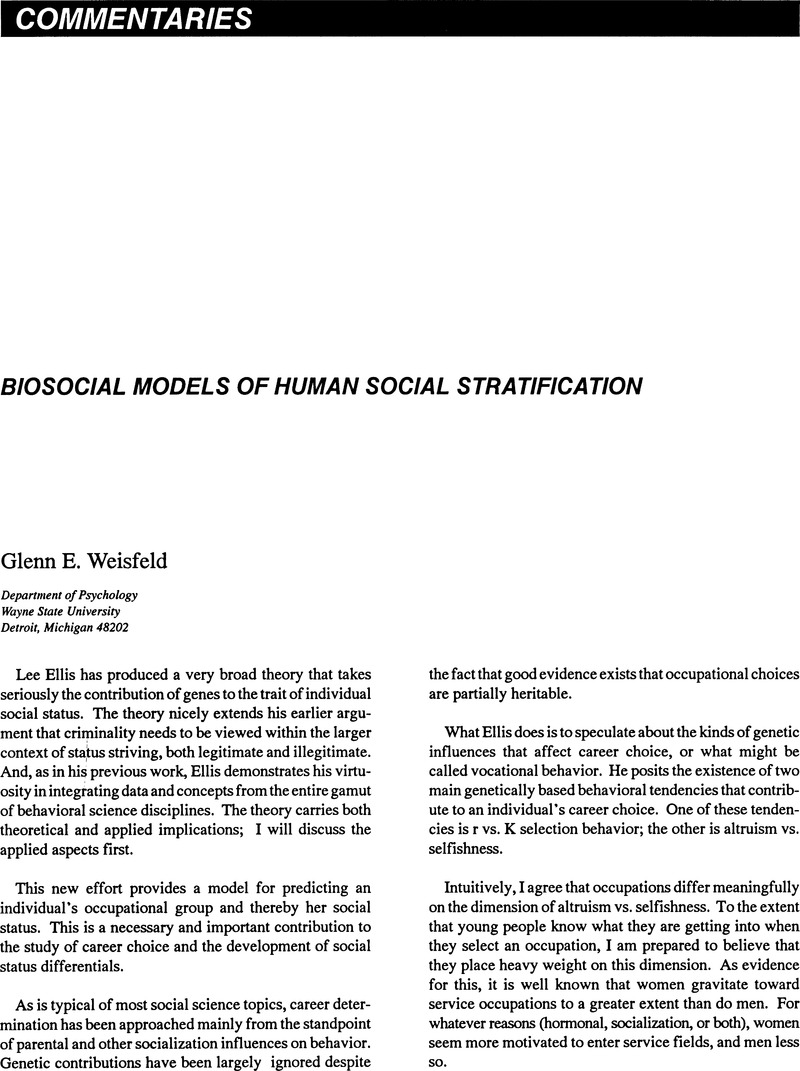No CrossRef data available.
Article contents
Biosocial Models of Human Social Stratification
Published online by Cambridge University Press: 17 May 2016
Abstract
An abstract is not available for this content so a preview has been provided. Please use the Get access link above for information on how to access this content.

- Type
- Articles and Commentaries
- Information
- Copyright
- Copyright © Association for Politics and the Life Sciences
References
Barkow, J. H.(1975). “Social Prestige and Culture: A Biosocial Interpretation.” Current Anthropology 16:553–572.CrossRefGoogle Scholar
Burgess, R. L., Kurland, J. A., and Pensky, E. E.(1988). “Ultimate and Proximate Determinants of Child Maltreatment: Natural Selection, Ecological Instability, and Coercive Interpersonal Contingencies.” In MacDonald, K. B.(ed.), Sociobiological Perspectives on Human Development. New York: Springer-Verlag.Google Scholar
Buss, D. M.(1989). “Sex Differences in Human Mate Preferences: Evolutionary Hypotheses Tested in 37 Cultures.” Behavioral and Brain Sciences 12:1–49.Google Scholar
Draper, P., and Harpending, H.(1988). “A Sociobiological Perspective on the Development of Human Reproductive Strategies.” In MacDonald, K. B.(ed.), Sociobiological Perspectives on Human Development. New York: Springer-Verlag.Google Scholar
Ellis, L.(ed.) (in prep.). Social Stratification and Socioeconomic Inequality: A Comparative Biosocial Analysis. New York: Praeger.Google Scholar
Ford, C. S., and Beach, F. A.(1951). Patterns of Sexual Behavior. New York: Harper and Row.Google Scholar
Howard, J. A., Blumstein, P., and Schwartz, P.(1987). “Social or Evolutionary Theories? Some Observations on Preferences in Human Mate Selection.” Journal of Personality and Social Psychology 53:194–200.CrossRefGoogle Scholar
Mazur, A.(1985). A Biosocial Model of Status in Face-to-Face Primate Groups. Social Forces 64:377–402.Google Scholar
Rajecki, D. W., and Flannery, R. C.(1981). “Social Conflict and Dominance in Children: A Case for A Primate Homology.” In Lamb, M. E.and Brown, A.(eds.), Advances in Developmental Psychology (Vol. 1). Hillsdale, NJ: Erlbaum.Google Scholar
Reed, F. W., Udry, J. R., and Ruppert, M.(1975). “Relative Income and Fertility: The Analysis of Individuals' Fertility in a Biracial Sample.” Journal of Marriage and the Family 37:799–805.CrossRefGoogle Scholar
Weisfeld, G. E.and Linkey, H. E.(1985). “Dominance Displays as Indicators of a Social Success Motive.” In Dovidio, J.and Ellyson, S.(eds.), Power, Dominance, and Nonverbal Behavior. New York: Springer-Verlag.Google Scholar
Weisfeld, G. E., Muczenski, D. M., Weisfeld, C. C., and Omark, D. R.(1987). “Stability of Boys' Social Success Among Peers Over an Eleven-Year Period.” In Meacham, J. A.(ed.), Contributions to Human Development (Vol. 18). Basel: Karger.Google Scholar


